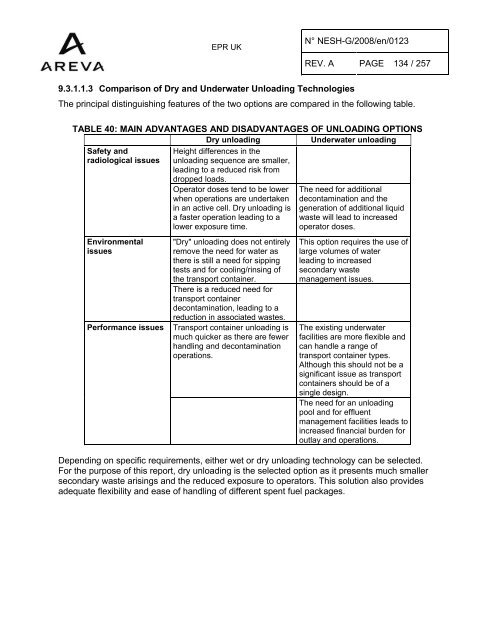Solid Radioactive Waste Strategy Report.pdf - UK EPR
Solid Radioactive Waste Strategy Report.pdf - UK EPR
Solid Radioactive Waste Strategy Report.pdf - UK EPR
Create successful ePaper yourself
Turn your PDF publications into a flip-book with our unique Google optimized e-Paper software.
<strong>EPR</strong> <strong>UK</strong><br />
N° NESH-G/2008/en/0123<br />
REV. A PAGE 134 / 257<br />
9.3.1.1.3 Comparison of Dry and Underwater Unloading Technologies<br />
The principal distinguishing features of the two options are compared in the following table.<br />
TABLE 40: MAIN ADVANTAGES AND DISADVANTAGES OF UNLOADING OPTIONS<br />
Dry unloading<br />
Underwater unloading<br />
Safety and<br />
radiological issues<br />
Environmental<br />
issues<br />
Performance issues<br />
Height differences in the<br />
unloading sequence are smaller,<br />
leading to a reduced risk from<br />
dropped loads.<br />
Operator doses tend to be lower<br />
when operations are undertaken<br />
in an active cell. Dry unloading is<br />
a faster operation leading to a<br />
lower exposure time.<br />
"Dry" unloading does not entirely<br />
remove the need for water as<br />
there is still a need for sipping<br />
tests and for cooling/rinsing of<br />
the transport container.<br />
There is a reduced need for<br />
transport container<br />
decontamination, leading to a<br />
reduction in associated wastes.<br />
Transport container unloading is<br />
much quicker as there are fewer<br />
handling and decontamination<br />
operations.<br />
The need for additional<br />
decontamination and the<br />
generation of additional liquid<br />
waste will lead to increased<br />
operator doses.<br />
This option requires the use of<br />
large volumes of water<br />
leading to increased<br />
secondary waste<br />
management issues.<br />
The existing underwater<br />
facilities are more flexible and<br />
can handle a range of<br />
transport container types.<br />
Although this should not be a<br />
significant issue as transport<br />
containers should be of a<br />
single design.<br />
The need for an unloading<br />
pool and for effluent<br />
management facilities leads to<br />
increased financial burden for<br />
outlay and operations.<br />
Depending on specific requirements, either wet or dry unloading technology can be selected.<br />
For the purpose of this report, dry unloading is the selected option as it presents much smaller<br />
secondary waste arisings and the reduced exposure to operators. This solution also provides<br />
adequate flexibility and ease of handling of different spent fuel packages.

















